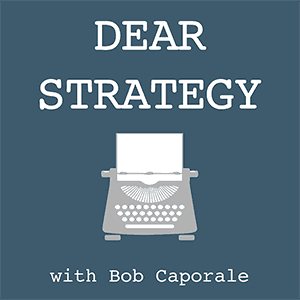Dear Strategy:
“How do we identify new entrants who are on the path to entering the industry with the intent of transforming it? When does it make sense to adjust your strategy to address that new threat?”
I really love where this question can go, but I don’t particularly love where it comes from. In today’s high-tech world, it seems as though many already established companies expect to be disrupted by someone other than themselves. And although it’s good to be aware of the fact that someone can, in fact, steal your hard-earned lunch money right out from under your nose, you haven’t done your job as a strategist simply by identifying that a threat might exist. Instead, you have to do something about it. So that’s what I’m going to focus on in today’s blog.
Despite my introductory rant, I truly am happy that this question is being asked –because it is this exact exercise that I ask people to complete when I deliver product strategy workshops. If you recall back in Episode 036, I provided some tips and tools on how to analyze competitive information. What I didn’t tell you in that episode is that I not only suggest you analyze your existing competitors, but I also recommend that you attempt to analyze at least one competitor that doesn’t yet exist.
If that sounds like a puzzling request, let me give you a quick example.
Today, Amazon is one of the largest and most successful businesses in the world. They are on the competitive radar of nearly every company I know of – from book stores, to big-box retailers, to web service companies, to logistics providers, to grocery stores, and on and on and on. The question is, why did it take someone outside of each of these industries to do what Amazon ultimately did? If the book stores had been anticipating that an Amazon might exist, maybe they would have disrupted themselves. If the big box retailers had been paying attention to what an unknown competitor might do, they might have done it first. And I can go on down the list of every company that Amazon disrupted – even to Apple who, at least from my view as a consumer, didn’t fully see them coming.
What I’m getting at is that the exercise isn’t necessarily to name the exact company that might disrupt you (although if you can guess it to that degree of accuracy, more power to you). Instead, the exercise is just to think about who has the means and the desire to disrupt you – and then do something about it.
When you think about your future competition in this way, you are naturally going to think about not only who they might be, but also what they might do and why they might do it. And that will give you a really big clue into what your strategy should be if you wanted to disrupt yourself.
The sad fact is that as many times as I have encouraged companies to do this exercise, and as many times as I have watched them identify truly viable potential disruptors to their respective industries, I have rarely see any of these companies do anything about it. So, to answer this question as succinctly as I can:
How do we identify potential disruptors and when does it make sense to address that threat?
Make it a part of your competitive analysis and address what you find long before that disruptor arrives. Which roughly translates to right now.
Listen to the podcast episode
Dear Strategy: Episode 045

###
Bob Caporale is the author of Creative Strategy Generation and the host of the Dear Strategy podcast. You can learn more about his work by visiting bobcaporale.com.




